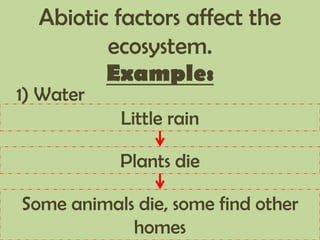TEMPERATURE AS ABIOTIC. Wind can cause mechanical damage to.

What Factors Influence Ecosystems
Temperature also affects an organisms metabolism and species have evolved to thrive in the typical temperature range in their ecosystem3.

. The leaves of the plant absorb the sunlight and carbon dioxide from the atmosphere. Abiotic factors can be categorized into. There are common factors that affect nearly all the habitat these are as.
It disperses seeds and spreads fire. In a terrestrial ecosystem examples might include temperature light and water. Biotic factors would include the availability of food organisms and the presence of biological specificity competitors.
Most terrestrial plant species are limited by a combination of temperature precipitation and. Rocks that created the highlands Planet Earth Mountain. The temperature of both the ambient air and bodies of water in a region impacts how plants animals and humans can survive in an ecosystem.
Describe two adaptations of the Gelada Baboon. Examples include people plants animals fungi and bacteria. It moves other abiotic factors like soil and water.
List three abiotic factors that influence the Ethiopian Highland ecosystem. Biotic Factors by Type. Therefore green plants biotic components are affected by water and carbon dioxide biotic components through photosynthesis.
The abiotic components in an ecosystem include all the physical and chemical elements which means the non-living components. These component may differ from region to region from ecosystem to ecosystem. These are components like minerals light heat rocks and water.
Abiotic factors comprise the following. Abiotic and biotic factors work together to create a unique ecosystem. Climate Humidity Precipitation Wind Altitude Type of soil Light penetration Water depth Oxygen content Turbidity.
Examples include soil water weather and temperature. Learn more about abiotic factors with this curated resource collection. In a marine ecosystem abiotic factors would include salinity and ocean currents.
Biotic and Abiotic Factors Influence on Ecosystems Terrestrial Ecosystems. Abiotic factors include ambient temperature amount of sunlight and pH of the water soil in which an organism lives. Natural disasters such as earthquakes volcanoes and forest fires are also abiotic factors.
Temperature and light are examples of abiotic factors that are linked together as the amount of sunlight an area gets impacts the ambient temperature in that region. Wind can exert many effects on an ecosystem. But wind increases the rate of transpiration and therefore water loss.
These types of abiotic factors certainly have. The limiting factor is the single component that limits. Climatic factor Edaphic factor Social factor Climatic factors include humidity sunlight and factors involving the climate.
Biotic factors are the living parts of the ecosystem such as plants animals insects fungi and bacteria. They are mainly the life supporters. Wind affects temperature as well as evaporation from soil air.
Most aquatic ecosystems are limited by salt concentration. Social factors include how the land is being used and water resources in the area. Therefore plants depend upon the abiotic factors of the ecosystem to make their food.
Edaphic refers to soil conditions so edaphic abiotic factors include soil and geography of the land. In a terrestrial ecosystem examples might include temperature light and water. Abiotic and biotic factors work together to create a unique ecosystem.
An environmental factor ecological factor or eco factor is any factor abiotic or biotic that influences living organisms. Biotic factors are the living organisms in an ecosystem. These consist of soil its water chemical and physical composition its pH nutrients.
ABIOTIC FACTOR AFFECTING AN ECOSYSTEM EDAPHIC ABIOTIC FACTORS. An abiotic factor is a non-living part of an ecosystem that shapes its environment. Abiotic factors are the non-living parts of the ecosystem which influence the size and composition of the living parts.
Planet Earth Video Questions. In a marine ecosystem abiotic factors would include salinity and ocean currents. Learn more about abiotic factors with this curated resource.
An ecosystem consists of biotic and abiotic factors. Wind can increase the supply of carbon dioxide to plants. ECOLOGICAL FACTORS COMMON TO ALL HABITATS.
Abiotic factors are the nonliving components of an ecosystem. They determine and restrict the population growth number and diversity of biotic.

Warm Up Activity Match The Pictures To The Correct Terms That Describe Them Ecosystem Biome Biosphere Ecosystems Biomes Teaching Science

1 How Biotic Abiotic Factors Influence The Biosphere Ecosystem 2 What Impact Biotic Abiotic Factors Have On Biodiversity Ppt Download
How Do Biotic Factors Depend On Abiotic Factors Quora

The Roles Of Archaea And Some Biotic And Abiotic Factors That Influence Download Scientific Diagram
0 Comments